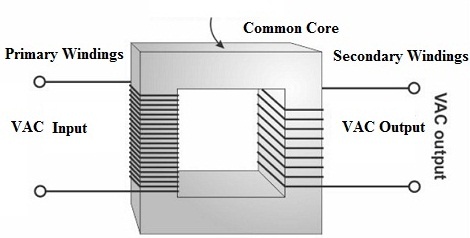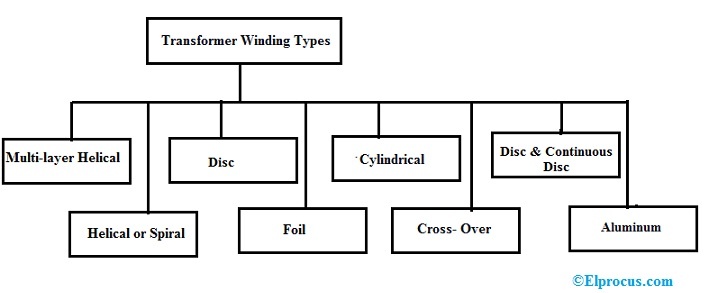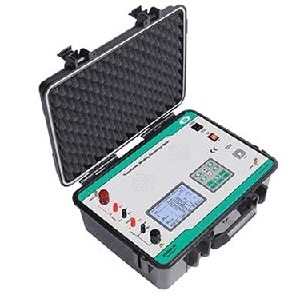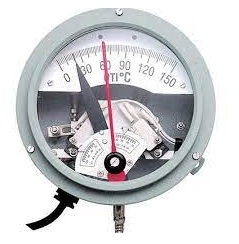A transformer is a static electrical machine, used to transfer AC from one circuit to other at a stable frequency through the process of electromagnetic induction, however, the voltage is increased or decreased based on the requirement. This device is used to step up or step down the voltage in the circuits. Every transformer includes different parts like core, windings, coil, insulating materials, conservator, oil, breather, tap changer, Buchholz Relay, cooling tubes, and explosion vent but, transformer winding plays a key role while functioning. So, this article discusses an overview of transformer winding, types, and their working.
What is Transformer Winding?
Transformer winding includes different turns of copper coil bundles where every bundle is connected to form a winding. Windings mainly depend on the input-output supply otherwise on the range of voltage. The transformer winding diagram is shown below.

Materials
Transformer winding materials are aluminum and copper which are the most frequently used conductors in transformer windings. The mechanical strength and conductivity are high for copper whereas aluminum materials are less cost and lightweight as compared to copper. Generally, copper windings are used in large transformers whereas aluminum conductors are used for small size and medium size transformers.
Transformer Winding Types
Transformer windings are available in different types like the following.

- Multi-Layer Helical Windings
- Helical Windings or Spiral Windings
- Disc Windings
- Foil Windings
- Cylindrical Windings
- Cross- Over Windings
- Disc & Continuous Disc Winding
- Aluminum Windings
Multi-Layer Helical Windings
These windings are mainly used for high voltage rating-based transformers like 110 kV & above. These types of windings comprise numerous cylindrical layers which are wounded & connected in series. The external layers of these transformer windings are made shorter as compared to the inside layers for allocating the capacitance consistently. These windings are mainly used to enhance the transformer’s surge behavior.
Helical Windings or Spiral Windings
Helical windings are known as spiral windings which are used for low voltage & high capacity-based transformers, where the flow of current is higher & the turns of winding are smaller. The transformer output changes from 160 to 1000 kilovolt-ampere & 0.23 to 15 Kilovolt.
For protecting sufficient mechanical power, the cross-sectional area of the strip is not made less than 75mm to 100mm square. The maximum number of strips that are used to make up the conductor in parallel is 16. These windings are available in three types like single helical, double helical, and Disc-helical.
- The winding which is in an axial direction along a screw line through inclination is called Single Helical Windings. These windings include simply one layer of turns in every winding.
- The double-helical type winding reduces the eddy current loss within conductors. So because of the reduced number of parallel conductors, these are used in a radial direction.
- The disc-helical winding is designed in such a way that the strips are connected side to side within a radial way to occupy the entire radial strength of the winding.
Disc Windings
The designing of disc windings can be done by connecting several conductor discs in series. Initially, a disc can be formed by winding different insulated conductor turns & after that connected in series to make disc winding. Every disc can be separated from the nearby disc with spacers.
The main disparity between a disc & helical winding is that the helical winding includes simply a single twist of parallel conductor for each disc whereas the disc winding includes numerous turns for each disc. Disc type windings are used in the above 25kV rated transformer. Similar to helical, these windings are also robust mechanically.
Foil Windings
Foil windings are mainly designed with thin aluminum or copper sheets where the thin insulated sheet is covered several times to make multilayer spiral windings. This winding can be formed either with a single or many sheets within a parallel wound on the plane side. These are applicable in high capacity-based transformers where the current ranges from 12 – 600 A.
Cylindrical Windings
These windings use low voltage up to 6.6 kV & their current rating ranges from 10 – 600 A. These windings are frequently used in multi-layer forms. In these types of windings, we utilize circular type conductors which are wounded on vertical strips to enhance cooling conditions.
This arrangement will create oil ducts to help better cooling. These windings are applicable where high voltage ratings are used up to 33 kV, 800 kVA & current ratings up to 80 A. For a bare conductor, the highest diameter size used is 4 mm.
Cross over Windings
Cross-over windings are used in small transformers. These windings are separated into several coils to decrease the voltage among contiguous layers where these coils are divided axially through 0.5 to 1 mm of distance. The voltages between contiguous coils should not be above 800 – 1000 V.
The actual axial length of every coil is approximately 50 mm whereas the spacing in two coils is 6 mm to hold insulating material blocks. The coil’s width ranges from 25mm to 50 mm. The strength of these windings is high as compared to cylindrical type windings in normal conditions.
Disc & Continuous Disc Winding
This type of winding is normally used in high capacity-based transformers where these windings include several discs or flat coils in a series or parallel configuration. The formation of these coils can be done using rectangular strips which are spirally wounded within a radial direction.
Here, the area of the conductor ranges from 4 to 50 mm square & the current ranges from 12 to 600 A. The least width of the transformer oil duct is 6 mm mainly for 35 kV. The main benefit of these types of windings is that they provide maximum mechanical axial strength.
Aluminum Windings
Aluminum windings are the most predominant choice to use in different transformers in North America like dry type and low voltage. In most areas all over the world, the copper winding is the main winding material but the main reason to choose this aluminum winding is its initial cost is low.
Aluminum winding is more flexible as compared to copper so making it very easy. The maximum resistivity of aluminum provides inherently fewer eddy losses within the windings. This reduces the possibility of hot spots. Transformers with aluminum winding or copper winding have the same losses & performance. Aluminum wound coils are bigger as compared to copper coils.
Transformer Winding Resistance Meter
The transformer winding resistance meter is an essential diagnostic device used for testing the transformer to know the assembling, poor design, maintenance, handling, and overloading. The transformer windings resistance measurement will assure that every circuit is properly connected & all the connections are tight.

In transformers, winding resistance will change because of the loose connections, shorted turns, etc. Apart from the configuration, the measurements of resistance are made normally phase-to-phase & the readings are evaluated with each other to conclude if they are okay. This meter is mainly designed to compute the resistance of winding in different types of transformers, generators, motor windings, Inductors, tap changers, power cables, bus bar contacts, etc. This meter is particularly designed for extremely high inductive objects like 400kV/220kV/765kV.
Transformer Winding Temperature Indicator
In the transformer, the winding is an essential component with high temperatures. So once the load increases then the winding temperature will be increased. Thus, to control the temperature parameter within the transformer, the top oil & winding temperature is measured. The winding temperature within the transformer is measured through WTI (Winding Temperature Indicator) & the Transformer Oil’s temperature is measured with Oil Temperature Indicator.

The main function of the Winding Temperature Indicator (WTI) is to specify the temperature of low voltage & high voltage winding of the Transformer to operate the trip, the alarm & cooler control contacts. In the below figure, the black needle shows the CWT (current winding temperature) whereas the red color needle shows the highest winding temperature.
Here, two handles are provided to set the winding temperature for the trip & alarm. The Green color handle shows the winding temperature setting for the Alarm whereas Red color handle shows the setting for Trip temperature.
Advantages
The advantages of transformer winding include the following.
- It avoids condensed flux leakage & iron loss.
- The mechanical strength of these windings is high
- It is very efficient while working with high frequencies.
- Less failure rate
- Less production cost
Disadvantages
The disadvantages of transformer winding include the following.
- Very hard to twist the windings
- Accuracy is less in positioning the coils so electrical characteristics & performance can be changed.
- Higher expenses on manual labor
Applications
The applications of transformer winding include the following.
- Transformers windings are two types where primary winding draws energy from the main source and the secondary winding transmits the energy to the load.
- In AC circuits, it increases or decreases the capacitor value or resistance or an inductor.
- It can increase or decrease the voltage or current level.
What is the LV side of the transformer?
In a transformer where low voltage (LV) winding is available then it is called as LV side.
What is the difference between 2 winding and 3 winding transformers?
The main difference between two winding and three winding transformers is that the two winding transformers are mainly used to change the voltage from one level to another level. Three winding transformers are used where three voltage levels are required.
What is primary winding?
A primary winding is the main winding in a transformer that is directly connected to the main supply so that it gets the energy directly.
What is the temperature gauge in the transformer?
Most of the transformers use an oil temperature gauge to measure the temperature of the actual top oil.
How do you measure the internal temperature of a winding?
The winding temperature of a transformer can be measured by using a thermometer & any type of sensor.
Thus, this is all about an overview of different types of transformer windings where the conductors are wounded around the core. The input and outputs of the transformer can be formed by the primary and secondary windings. The construction of these windings must be stable in the transformer for secure operation. The selection of an appropriate winding for a transformer can be done based on the VA rating. Here is a question for you, what are the different types of transformers available in the market?

